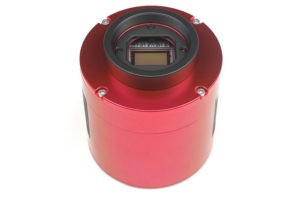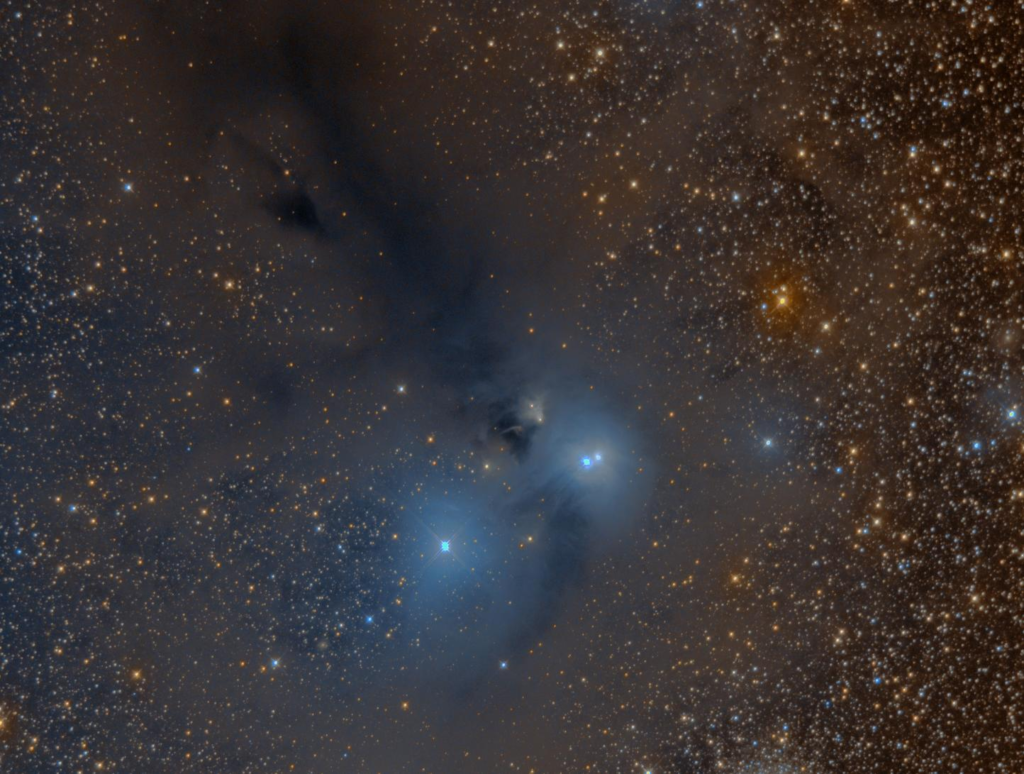The ZWO ASI1600MM Pro camera is a cooled CMOS sensor-based astronomy camera that entered the market in 2016, causing quite a storm. At the time, only CCD cameras were thought to be adequate for astrophotography, but the ASI1600 camera in its early revisions changed the minds of astrophotographers worldwide with stunning images not thought to be possible, which is the main reason that CMOS astronomy cameras are popular today.
The camera was first released in 2016 and has seen many revisions throughout its lifetime. At the moment, it is most commonly seen in its monochrome, cooled form; however, there are also color versions available. The camera is seen as a competitor against the KAF-8300 sensor range of cameras, which were common before the 1600 came around. Today I will be talking about why this camera has brought astrophotography into a new golden age where anyone can take great images with cameras like the ASI1600MM Pro.
Technical Specs
The camera’s main selling point is that it includes a CMOS sensor, which in the past was exclusively used with smaller cameras mainly intended for planetary applications where long exposures were unnecessary. The advantage that a CMOS sensor has is that it is the newest technology, and as such, its noise levels are greatly reduced, and sensitivity is also increased in contrast to a CCD sensor.
The camera has a micro 4/3rds format sensor, which is a bit smaller than the sensors you find in APS-C format cameras in most DSLRs but much larger than a mobile phone sensor. It has an amazingly high 16MP resolution, or 4656 x 3520 pixels, meaning that you can take 4K resolution images with this camera or crop in editing for smaller deep-sky objects, an advantage over its predecessor cameras, which typically had low resolutions, barely enough to fit on a 1080p screen.

The pixel size of the camera is 3.8 microns, meaning that this camera has smaller pixels than usual. The advantages and disadvantages behind this are a controversial topic regarding this camera, which will be covered in a later section.
Another important feature is that this camera has a strong cooling system. In any camera sensor, there is always some source of noise or grain in the image created by unwanted sources, and the 1600 is no exception.
In camera sensors, a large source of image noise comes from heat, which can be either from the outside air or from the camera heating itself up after long use. Cooling the camera sensor down is a commonly used trick to greatly reduce levels of noise in astrophotography. This camera can cool to 50 degrees below ambient, ensuring you have almost no noise for clean images!
Another feature is that it can take long exposures up to 30 minutes, sure to capture the faintest of deep-sky targets! It can also do video recordings, for work in planetary and occultations but there are certainly better cameras to fit those jobs as the 1600’s sensor is so large, planets would appear to be tiny, but for this reason, the 1600 also excels in astrophotography.
What’s so good about this camera?
The reason why the ASI1600’s popularity is far higher than any other cameras on the market is because of the innovative design that went into this camera by ZWO. The camera’s sensor and the hardware and features included in the camera are what I will discuss here.
This section could get a tad technical, but I will try to keep it as simple as possible.
- The camera’s sensor, a sony monochrome, is the heart of 1600.
- We use monochrome sensors more commonly than not because color sensors include something called a Bayer matrix.
- The Bayer matrix is an array or matrix of colored windows over each pixel, which allows cameras to pick up colors. The problem with this is that the filters can block up to about 80% of light incoming.
- The huge amount of light lost to the filters is usually no problem in the daytime when you have the sun to illuminate your subjects, but when you are trying to take photos of the dimmest targets, the extra 80% of light can help greatly.
- We get color photos with monochrome cameras by simply placing filters in front of the sensor, for RGB images red, green, and blue, but we can also make more interesting images by filtering out common nebula wavelengths such as Hydrogen-Alpha, Oxygen 3 and Sulphur 2.
- The sensor is also much more efficient at picking up light than others in the field. This is a common trait of CMOS sensors have and the 1600 has a peak efficiency of over 60%, where CCD cameras have closer to 40-50 % on average, which helps you pick up fainter objects. The sensor also has a low read noise of about 1.2e- Read noise is a differing trait that all cameras have which describes the minimum amount of noise the camera has. The ASI1600 has a particularly low amount of read noise compared to the KAF 8300 and other CCD cameras with a read noise around 8e-.
- The camera has a very close sensor to its face. This means that you can fit many more accessories into the sometimes narrow space allowed by coma correctors or even RASA/Hyperstar setups. Cameras like DSLRs take up much more space that can be critically important to maintain round stars at the edges of your images if you use something like a coma corrector or field flattener.
Using the Camera
The ASI1600 has many reasons it is well-loved amongst astrophotographers, but some of the best features found are the ones that make it great to use out in the field; after all, it is a camera and not just a piece of equipment to look at.
The camera has USB 3.0, which makes downloading frames on your computer super speedy with a low risk of losing precious data. Speaking of USB ports, the camera has an onboard USB hub with two USB 2.0 ports, so you can plug in two extra devices without using up more USB ports on your laptop. You might want to use these ports with devices that do not require high-speed connections, such as a filter wheel or autofocuser.
The camera has full ASCOM compatibility, meaning that practically any capture software of your choice can be used with this camera. You can take videos in programs like SharpCap and FireCap, and even polar align from SharpCap if your telescope’s field of view is wide enough. I recommend using the camera with deep-sky capture programs that have ASCOM support, like SGP, NINA, APT, and so on, powerful capture tools that you can use to set up sequences overnight to take photos without having to press a button if you are more serious about astrophotography.
From the computer, you also have the option to adjust the camera’s gain. This is a system similar to ISO in a DSLR camera; however, unlike a DSLR, you can pick any value that you desire. Gain is the amount that the camera cranks up its capture brightness, which does not actually give you more data. It can still be helpful to refine your gain because if you use too high a value, you can overexpose or get noisy images. The system in the camera and software to cool down are also quite intuitive. In every capture software listed above, you can find some sort of cooldown feature that you can set to up to 50 degrees below the ambient temperature. For example, if it is 20° out, you can go to -30° on camera.
In general, the ASI1600 is a joy to use for beginners and dedicated astrophotographers alike, as it is easy and intuitive to use as an astrophotography camera. It is a powerful tool used to take incredible images.

What’s not to love?
Of course, there is no such thing as a free lunch. There will always be some things that have disadvantages and nothing is perfect.
This applies to this camera, but the issues I will discuss below are quite controversial in astrophotography communities because no one is quite sure just how bad these issues are or if they are worth reconsidering buying the camera over. In my opinion, however, they are quite minor.
In no particular order:
- The small size of the camera’s pixels, while allowing for a higher resolution image, means that each pixel takes in less light than a similar larger pixel because the surface area is smaller. This is a trade-off of having a higher resolution sensor.
- Another issue that can arise from this is that as the pixels are so tiny, you can reach your telescope’s maximum magnification or enhance before minor guiding issues, but that is more related to your telescope and mount. I believe that this is not a huge issue as the other factors of sensitivity make having smaller pixel sizes worth it.
- The sensor made by sony comes from the factory with a window preinstalled that can be harmful to astrophotography as it reflects light from bright stars back onto the filters and then the sensor. In most cases, you do not notice this issue as the objects in space are too dim to cause these reflections. When you do take photos of fairly bright stars or other bright objects you can see an ugly microlensing pattern projected onto the image around the area of the star.
- The sensor itself can not expose quite as bright as some other sensors without overexposing. This happens when your exposures are too long or the
gain is set too high, star cores in your image can become overexposed and all data is ruined in the cores. The implication of this is that cores of stars appear pure white in images.
Conclusion
To conclude my review of the ASI1600MM Pro, I would like to say that the features included in this camera make it an awesome tool to improve your images. The ASI1600MM Pro is easy to use for both beginners and high-level amateurs alike and has produced some of the best images in recent years. You can grab the camera and take photos without doing much, or go deep in-depth into the science behind CMOS sensors to get every inch of performance out of the camera, and it is sure to make you not regret your purchase.
The disadvantages the camera has can mostly be ignored but can sometimes be noticeable depending on what you are doing, but in my opinion, I would not let these annoyances distract you from the great value and performance of the ASI1600MM Pro.
